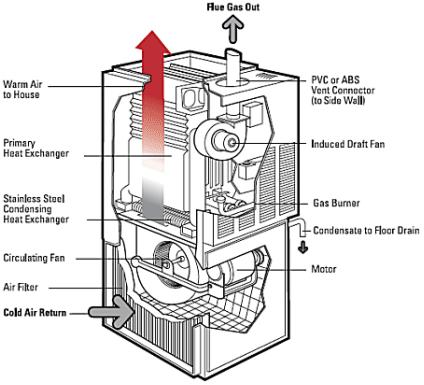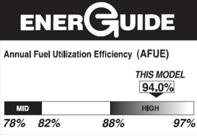ENERGY STAR gas furnace tips
Choose the right condensing gas furnace
Condensing gas furnaces are the most energy-efficient furnaces on the market today. They are an ideal choice as a new or replacement furnace for virtually any home serviced by natural gas or propane. Here is why
Condensing gas furnaces have an annual fuel utilization efficiency (AFUE) of between 90 and 97 per cent , compared with AFUEs of about 60 per cent for old furnaces and of 78 to 84 per cent for standard efficiency units. (AFUE is the yardstick for rating furnace efficiency.)
Because of their increased efficiency, condensing gas furnaces use, on average, 33 to 38 per cent less energy than old models and 10 per cent less energy than a standard efficiency model. This helps conserve Canada's natural resources and reduces harmful environmental emissions that contribute to climate change, urban smog and other air pollution problems.
Any extra cost associated with purchasing a condensing gas furnace will be quickly recovered through energy savings. For example, a homeowner with an old gas furnace could save about $300 a year by switching to a condensing gas furnace with an AFUE of 96 per cent .
Condensing gas furnaces are available in a range of sizes. They can be installed in the same location as the furnace that is being replaced, by the same technicians and by using the same ductwork.
Look for the EnerGuide label
To determine the efficiency level of a gas furnace, check its EnerGuide rating on the back page of the manufacturer's brochure – the higher the rating, the more efficient the model. Check where the EnerGuide rating is situated on the scale to see if the furnace you are buying is in the high-efficiency zone.
ENERGY STAR
Natural Resources Canada's Office of Energy Efficiency promotes the international ENERGY STAR symbol in Canada. The symbol identifies products that use less energy, thereby helping you save money and help protect the environment. The symbol can be found on the furnace, on the packaging or in promotional or educational literature. Only the top energy performers are eligible to use the ENERGY STAR symbol – residential gas furnaces must have an AFUE rating of 90 or higher to qualify.
If you decide to purchase a high-efficiency furnace, you should also consider installing a programmable thermostat that will allow you to preset household temperatures for specific times of the day and night. As a general rule, you can save 2 per cent on your heating bill for every 1°C you turn down the thermostat. However, the temperature setback should not be set lower than 17°C. Some thermostats offer you the ability to separate weekday and weekend programs, each with up to four customized temperature settings, thereby maximizing your energy savings.
Facts at a glance
- Ensure the AFUE is over 90 per cent
- Look for the ENERGY STAR symbol
- Use a programmable thermostat
- Determine the right size of furnace for your home
ENERGY STAR the international symbol for energy efficiency
How the technology works
In a furnace, combustion gases generated by the burner pass across a heat exchanger and release heat before being exhausted to the outdoors through a chimney. High-efficiency furnaces use additional heat exchange surfaces made of corrosion-resistant materials to cool and condense the combustion gases (causing them to liquefy), thus releasing more heat for the home. The small amount of wastewater produced by this process is piped to a floor drain.
This condensing process has another important benefit. It reduces the temperature of the flue gases to the point where they can be vented through a PVC or ABS plastic pipe out a side wall of the house. This eliminates the need for a chimney, which is a major source of heat loss in homes with old furnaces.

About fan motors
A standard fan motor is sometimes called a permanent split-capacitor (PSC) motor. When used in continuous operation all year long, for either heating or cooling, this motor will consume more electricity than an average refrigerator. Depending on the efficiency of the motor, energy use can go as high as 800 kWh/yr. Overall, energy consumption can be reduced using higher-efficiency options.
Some high-efficiency furnaces deliver even greater energy savings by using a variable-speed, direct current electronically commutating motor to run the air circulation fan. In homes where the fan is run continuously or for extended periods, such a motor can significantly reduce electricity consumption while providing better heat distribution. Consider this type of motor for your furnace, heat recovery ventilator or heat pump.
In addition to energy savings, these types of motors have long maintenance-free continuous operation. Less heat is generated in the rotor, allowing the bearings to run cooler. This reduces motor noise and increases bearing/motor life expectancy. Variable speed motors create less heat, compared with traditional PSC motors, and therefore can reduce the summer cooling load in air-conditioned homes.

